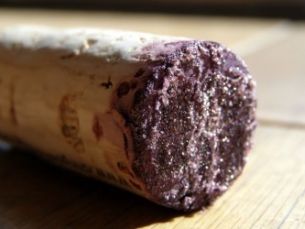Blog
What is all the Fuss about Tartrate Crystals?
03/25/2015

Have you ever pulled a cork on a bottle of wine and seen what looked like broken glass glued to the bottom of the cork?
Some people get freaked out about it but the fact is, it's totally harmless. Others think it's sediment, but they would be incorrect as well. Tartrates -- affectionately known by industry professionals as “wine diamonds” -- are tiny, crystalline deposits that occur in wines when potassium and tartaric acid, both naturally occurring products of grapes, bind together to form a crystal.
First, let's deal with tartrate crystals. They are formed when a method called cold stabilization is performed on a wine. Cold stabilization is often done on wine to remove excess potassium bitartrate, a natural substance found in grapes also known as "cream of tartar." Grapes contain fairly large amounts of potassium bitartrate. If most of it is not removed, the wine will form crystals when placed in the refrigerator. These tartrate crystals will either cling to the underside of the cork, if the bottle is on its side, or fall to the bottom of the bottle, if it's standing up, where they appear to be ground glass to the uneducated eye. It is completely harmless to the wine but quite interesting to the eye.
Now, let's deal with the next question that comes up. Some people wonder whether the presence of tartrate crystals affects or even reflects the quality of the wine. The answer is simply, no. Actually, the presence of tartrate crystals is viewed by many winemakers, sommeliers and academics as a sign of quality -- indicating that the wine was not over processed, thus creating a more natural and complex wine. Wine crystals are neutral and never impart an unpleasant taste.
I often get the question of what causes sediment in wine. Sediments in red wine are typically of two types: colloids and tartrates. The smaller, grainier types of sediment are colloids; they typically form much more slowly in wines meant for aging, and will start to form slight noticeable deposits after a few years. I’ll discuss this topic more fully in a future blog post. However, the second type of sediment is caused by the formation of the tartrate crystals. The creation of this type of crystals and their ability to form sediment is enhanced by cooler temperatures. Normally red wines spend two winters maturing in oak casks, which allow the tartrates to form in the barrel and to be removed from the wine prior to bottling. The difficulty with red wines is that they can often hold more tartrates in solution than would be expected because the alcohol tends to prevent the tartrates from settling out. Basically, in two years’ time, the wine may not have dropped all of its tartrate. In this instance, you may see it as one type of sediment. Again, the formation of this type of sediment is often a sign of a “hands-off” approach to winemaking allowing nature to offer complexity.
Finally, how should I serve wine that has tartrate crystals…you ask? If wine diamonds appear on a cork, simply wipe them away with a cloth. If their appearance in a glass is disagreeable to the consumer, decant the last quarter-bottle of wine, leaving any crystals behind.
Let's discuss your thoughts on it. I'll look forward to reading your comments and responding to your questions.
Post By:
Blair Allan
Add a comment
Comments are subject to approval and may not post immediately.

